

The Color of Law. On February 18, 1965, a civil-rights worker named James Orange was arrested in Marion, Alabama, on charges of disorderly conduct and contributing to the delinquency of minors, and was thrown into the local jail.
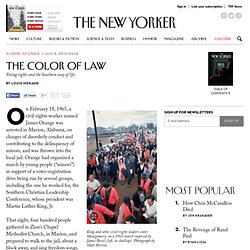
Orange had organized a march by young people (“minors”) in support of a voter-registration drive being run by several groups, including the one he worked for, the Southern Christian Leadership Conference, whose president was Martin Luther King, Jr. That night, four hundred people gathered in Zion’s Chapel Methodist Church, in Marion, and prepared to walk to the jail, about a block away, and sing freedom songs. They left the church at nine-thirty and ran into a police blockade. Ordered to disperse, they were attacked by fifty or more state troopers and other law-enforcement officials wielding clubs. Street lights had been turned off or shot out; white vigilantes were on the scene; reporters were attacked and cameras were smashed. Screws v. King understood this perfectly. "The First Freedom Ride:" Bayard Rustin On His Work With CORE. World War II was a period of economic and social advance for African Americans, and many who served overseas in the military, worked in defense industries, and listened to wartime propaganda about freedom became more assertive in their demands for equal rights.
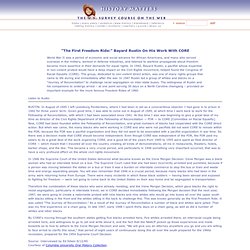
In 1942, Bayard Rustin, a pacifist whose expertise in non-violent protest would have a deep impact on the Civil Rights movement, helped found the Congress of Racial Equality (CORE). The group, dedicated to non-violent direct action, was one of many rights groups that came to life during and immediately after the war. In 1947 Rustin led a group of whites and blacks on a “Journey of Reconciliation” to challenge racial segregation on inter-state buses. The willingness of Rustin and his companions to undergo arrest – at one point serving 30 days on a North Carolina chaingang – provided an important example for the more famous Freedom Rides of 1960. Bayard Rustin reads the demands of the March - WGBH Open Vault. The Martin Luther King Jr. Center for Nonviolent Social Change. Www-personal.umich.edu/~gmarkus/MLK_WhereDoWeGo.pdf. Musarium: Without Sanctuary: Lynching Photography in America.
What was Jim Crow. Jim Crow was the name of the racial caste system which operated primarily, but not exclusively in southern and border states, between 1877 and the mid-1960s.
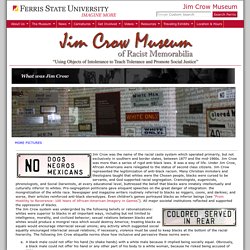
Jim Crow was more than a series of rigid anti-black laws. It was a way of life. Under Jim Crow, African Americans were relegated to the status of second class citizens. Jim Crow represented the legitimization of anti-black racism. Many Christian ministers and theologians taught that whites were the Chosen people, blacks were cursed to be servants, and God supported racial segregation. A black male could not offer his hand (to shake hands) with a white male because it implied being socially equal. Veterans of the Civil Rights Movement.
Literacy Tests & Voter Applications Alabama Georgia Louisiana: Mississippi South Carolina Background Today, most citizens register to vote without regard to race or color by signing their name and address on something like a postcard. Prior to passage of the federal Voting Rights Act in 1965, Southern states maintained elaborate voter registration procedures deliberately designed to deny the vote to nonwhites. American Experience.Eyes on the Prize.Primary Sources. Primary Sources return to index President Lyndon B. Johnson delivered the Commencement Address at Howard University on June 4, 1965. In the speech, he explained why affirmative action policies were necessary to achieve true equality in America. Great Speeches Collection: Nelson Mandela Speech - I am Prepared to Die. Lewis, “Speech at the March on Washington,” Speech Text. [1] We march today for jobs and freedom, but we have nothing to be proud of.

For hundreds and thousands of our brothers are not here. For they are receiving starvation wages, or no wages at all. While we stand here, there are sharecroppers in the Delta of Mississippi who are out in the fields working for less than three dollars a day, twelve hours a day. While we stand here there are students in jail on trumped-up charges. Our brother James Farmer, along with many others, is also in jail. . [2] It is true that we support the administration’s civil rights bill. . [3] As it stands now, the voting section of this bill will not help the thousands of black people who want to vote. . [4] We must have legislation that will protect the Mississippi sharecropper who is put off of his farm because he dares to register to vote.
5. Lynching, Politics, The Making of African American Identity: Vol. II, 1865-1917, Primary Resources in U.S. History and Literature, Toolbox Library. Plessy v Ferguson. PLESSY v.
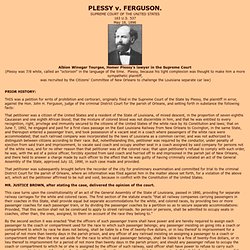
Publishing the Long Civil Rights Movement. By Angelina Ray Johnston and Robinson Wise Confederate Monument at Arlington National Cemetery in Arlington, Virginia, [This is the second of 4 installments of an essay that was originally published here.]
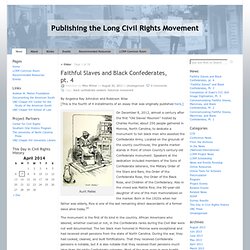
The “Faithful Slaves” monument in Mebane (see first installment of this essay) is just one example of the regional, even national, enthusiasm for commemorating “mammies” and “faithful slaves.”